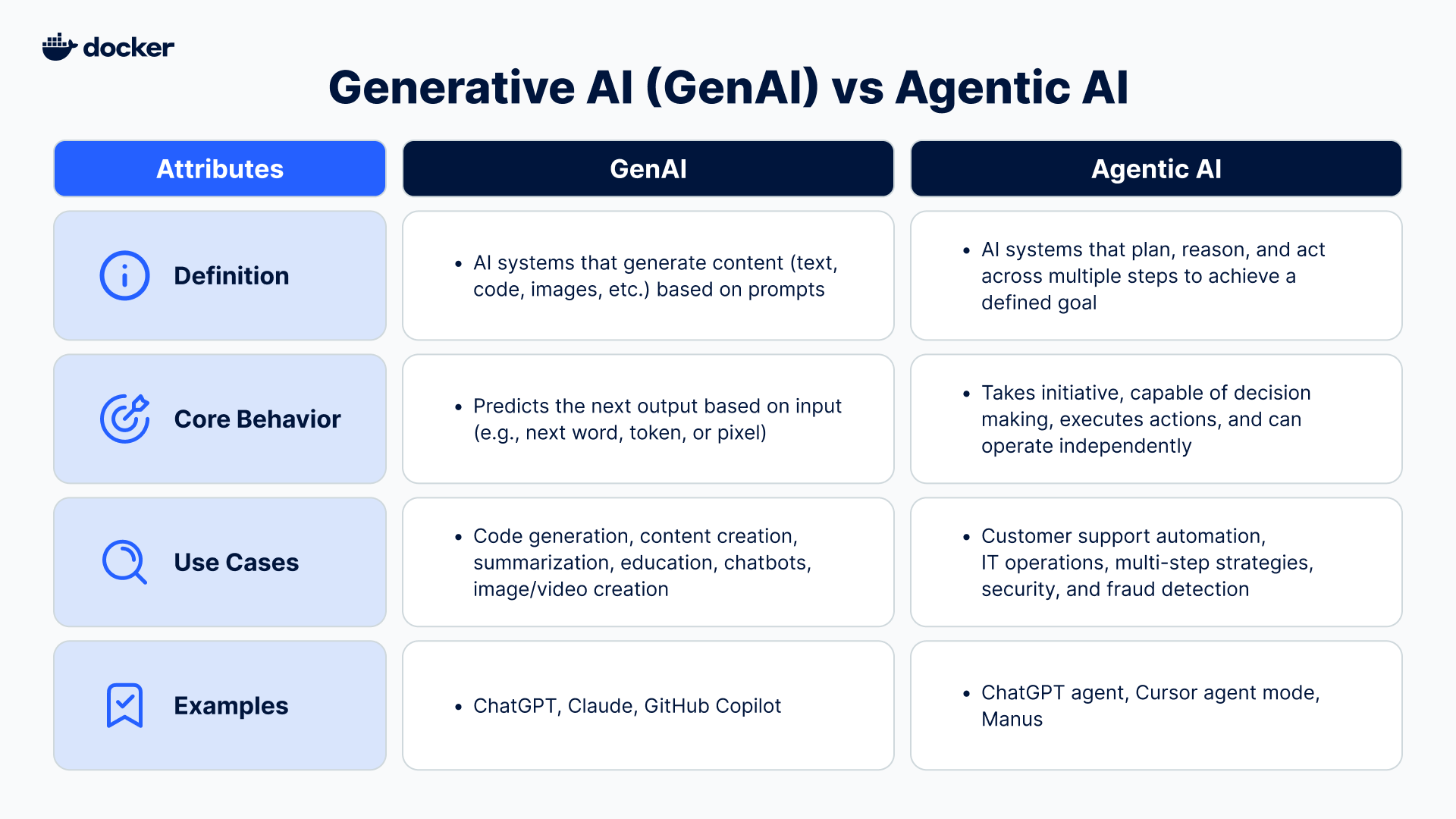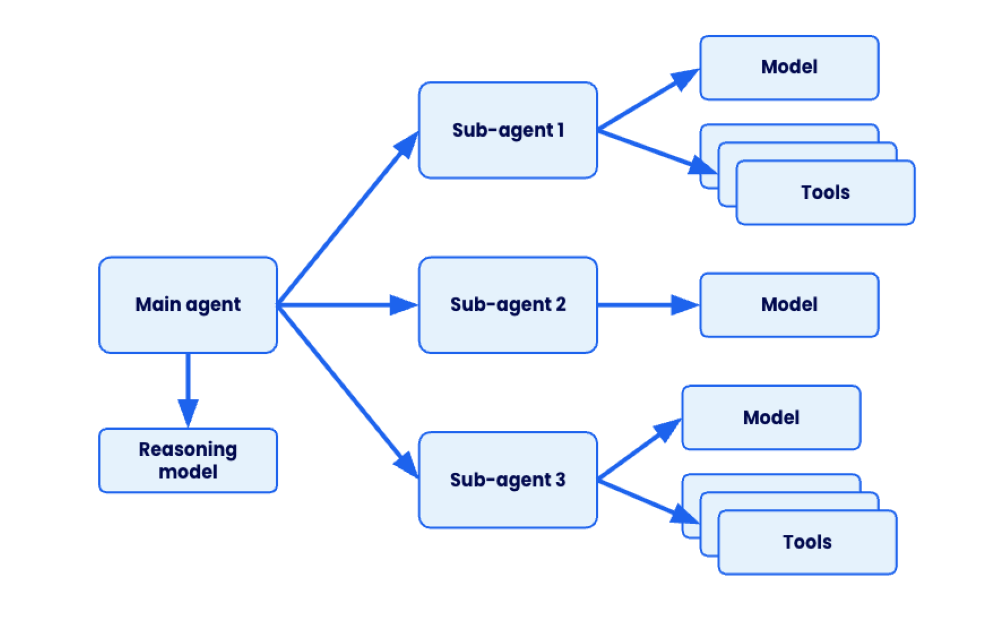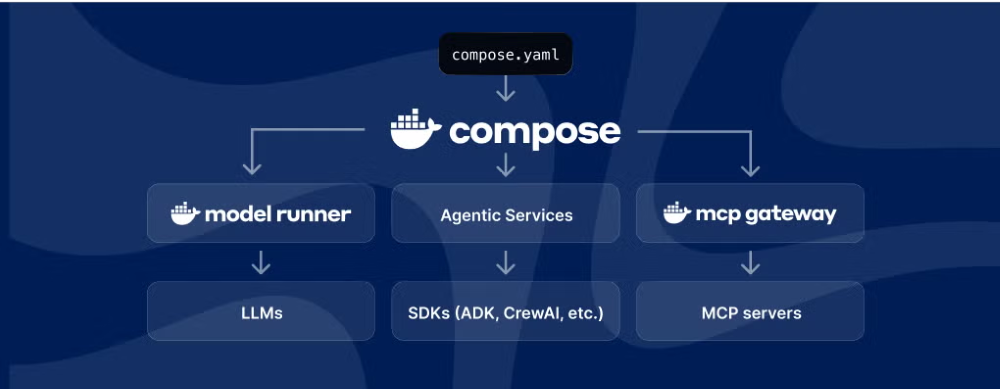Generative AI (GenAI) and the models behind it have already reshaped how developers write code and build applications. But a new class of artificial intelligence is emerging: agentic AI. Unlike GenAI, which focuses on content generation, agentic systems can plan, reason, and take actions across multiple steps, enabling a new approach to building intelligent, goal-driven agents.
In this post, we’ll explore the key differences between GenAI and agentic AI. More specifically, we’ll cover how each is built, their challenges and trade-offs, and where Docker fits into the developer workflow. You’ll also find example use cases and starter projects to help you get hands-on with building your own GenAI apps or agents.

Figure 1: Diagram visualizing the difference between GenAI vs. agentic AI.
What is GenAI?
GenAI is a subset of machine learning and powered by large language models to create new content, from writing text and code to creating images and music based on prompts or input. At their core, generative AI models are prediction engines. Trained on vast data, these models learn to guess what comes next in a sequence. This could be the next word in a sentence, the next pixel in an image, or the next line of code. Some even call GenAI autocomplete on steroids. Common examples include ChatGPT, Claude, and GitHub Copilot.
Use cases for GenAI
Top use cases of GenAI are coding, image and video production, writing, education, chatbot, summarization, workflow automation, and across consumer and enterprise applications (1). To build an AI application with generative models, developers typically start by looking at the use cases, then choosing a model based on their goals and performance needs. The model can then be accessed via remote APIs (for hosted models like GPT-4 or Claude) or run locally (with Docker Model Runner or Ollama). This distinction shapes how developers build with GenAI: locally hosted models offer privacy and control, while cloud-hosted ones often provide flexibility, state-of-the-art models, and larger compute resources.
Developers provide user input/prompts or fine-tune the model to shape its behavior, then integrate it into their app’s logic using familiar tools and frameworks. Whether building a chatbot, virtual assistant, or content generator, the core workflow involves sending input to the model, processing its output, and using that output to drive user-facing features.

Figure 2: A simple architecture diagram of how GenAI works
Despite their sophistication, GenAI systems remain fundamentally passive and require human input. They respond to static prompts without understanding broader goals or retaining memory of past interactions (unless explicitly designed to simulate it). They don’t know why they’re generating something, only how, by recognizing patterns in the training data.
GenAI application examples
Millions of developers use Docker to build cloud-native apps. Now, you can use similar commands and familiar workflows to explore generative AI tools. Docker’s Model Runner enables developers to run local models with zero hassle. Testcontainers help to quickly spin up integration testing to evaluate your app by providing lightweight containers for your services and dependencies.
Here are a few examples to help you get started.
1. Getting started with running models locally
A simple chatbot web application built in Go, Python, and Node.js that connects to a local LLM service to provide AI-powered responses.
2. How to Make an AI Chatbot from Scratch using Docker Model Runner
Learn how to make an AI chatbot from scratch and run it locally with Docker Model Runner.
3. Build a GenAI App With Java Using Spring AI and Docker Model Runner
Build a GenAI app with RAG in Java using Spring AI, Docker Model Runner, and Testcontainers.
4. Building an Easy Private AI Assistant with Goose and Docker Model Runner
Learn how to build your own AI assistant that’s private, scriptable, and capable of powering real developer workflows.
5. AI-Powered Testing: Using Docker Model Runner with Microcks for Dynamic Mock APIs
Learn how to create AI-enhanced mock APIs for testing with Docker Model Runner and Microcks. Generate dynamic, realistic test data locally for faster dev cycles.
What is agentic AI?
There’s no single industry-standard definition for agentic AI. You’ll see terms like AI agents, agentic systems, or agentic applications used interchangeably. For simplicity, we’ll just call them AI agents.
AI agents are AI systems designed to take initiative, make decisions, and carry out complex tasks to achieve a goal. Unlike traditional GenAI models that respond only to individual human prompts, agents can plan, reason, and take actions across multiple steps. This makes agents especially useful for open-ended or loosely defined tasks. Popular examples include OpenAI’s ChatGPT agent and Cursor’s agent mode that completes programming tasks end-to-end.
Use cases for agentic AI
Organizations that have successfully deployed AI agents are using them across a range of high-impact areas, including customer service and support, internal operations, sales and marketing, security and fraud detection, and specialized industry workflows (2). But despite the potential, adoption is still in its early stages from a business context. A recent Capgemini report found that only 14% of companies have moved beyond experimentation to implementing agentic AI.
How agentic AI works
While implementations vary, most AI agents consist of three main components: models, tools, and an orchestration layer.
- Models: Interprets high-level goals, reasons, and breaks them into executable steps.
- Tools: External functions or systems the agent can call. The Model Context Protocol (MCP) is emerging as the de facto standard for connecting agents to external tools, data, and services.
- The orchestration layer: This is the coordination logic that ties everything together. Frameworks like LangChain, CrewAI, and ADK manage tool selection, memory, planning, and state and control flow.

Figure 3: A high-level architecture diagram of how a multi-agent system works.
To build agents, developers typically start by breaking a use case into concrete workflows the agent needs to perform and identifying key steps, decision points, and the tools required to get the job done. From there, they choose the appropriate model (or combination of models), integrate the necessary tools, and use an orchestration framework to tie everything together. In more complex systems, especially those involving multiple agents, each agent often functions like a microservice, handling one specific task as part of a larger workflow.
While the agentic stack introduces some new components, much of the development process will feel familiar to those who’ve built cloud-native applications. There’s the complexity of coordinating loosely coupled components. There’s a broader security surface, especially as agents get access to sensitive tools and data. It’s no wonder some in the community have started calling agents “the new microservices.” They’re modular, flexible, and composable, but they also come with a need for secure architecture, reliable tooling, and consistency from development to production.
Agentic AI application examples
As agents become more modular and microservice-like, Docker’s tooling has evolved to support developers building and running agentic applications.

Figure 4: Docker’s AI technology ecosystem, including Compose, Model Runner, MCP Gateway, and more.
For running models locally, especially in use cases where privacy and data sensitivity matter, Docker Model Runner provides an easy way to spin up models. If models are too large for local hardware, Docker Offload allows developers to tap into GPU resources in the cloud while still maintaining a local-first workflow and development control.
When agents require access to tools, the Docker MCP Toolkit and Gateway make it simple to discover, configure, and run secure MCP servers. Docker Compose remains the go-to solution for millions of developers, now with support for agentic components like models, tools, and frameworks, making it easy to orchestrate everything from development to production.
To help you get started, here are a few example agents built with popular frameworks. You’ll see a mix of single-agent and multi-agent setups, examples using single and multiple models, both local and cloud-hosted, offloaded to cloud GPUs, and demonstrations of how agents use MCP tools to take actions. All of them run with just a single Docker Compose file.
1. Beyond the Chatbot: Event-Driven Agents in Action
This GitHub webhook-driven project uses agents to analyze PRs for training repositories to determine if they can be automatically closed, generate a comment, and then close the PR.
2. SQL Agent with LangGraph
This project demonstrates an AI agent that uses LangGraph to answer natural language questions by querying a SQL database.
3. Spring AI + DuckDuckGo
This project demonstrates a Spring Boot application using Spring AI and the MCP tools DuckDuckGo to answer natural language questions.
4. Building an autonomous, multi-agent virtual marketing team with CrewAI
This project showcases an autonomous, multi-agent virtual marketing team built with CrewAI. It automates the creation of a high-quality, end-to-end marketing strategy from research to copywriting.
5. GitHub Issue Analyzer built with Agno
This project demonstrates a collaborative multi-agent system built with Agno, where specialized agents, including a coordinator agent and 3 sub-agents, work together to analyze GitHub repositories.
6. A2A Multi-Agent Fact Checker
This project demonstrates a collaborative multi-agent system built with the Agent2Agent SDK (A2A) and OpenAI, where a top-level Auditor agent coordinates the workflow to verify facts.
More agent examples can be found here.
GenAI vs. agentic AI: Key differences
|
Attributes |
Generative AI (GenAI) |
Agentic AI |
|---|---|---|
|
Definition |
AI systems that generate content (text, code, images, etc.) based on prompts |
AI systems that plan, reason, and act across multiple steps to achieve a defined goal |
|
Core Behavior |
Predicts the next output based on input (e.g., next word, token, or pixel) |
Takes initiative, capable of decision-making, executes actions, and can operate independently |
|
Examples |
ChatGPT, Claude, GitHub Copilot |
ChatGPT agent, Cursor agent mode, Manus |
|
Top Use Cases |
Code generation, content creation, summarization, education, chatbots, image/video creation |
Customer support automation, IT operations, multi-step strategies, security, and fraud detection |
|
Adoption Stage |
Widely adopted across consumer and enterprise applications |
Early-stage; 14% of companies using at scale |
|
Development Workflow |
– Choose model – Prompt or fine-tune – Integrate with app logic |
– Break use case into steps – Choose model(s) and tools – Use a framework to coordinate agent flow |
|
Common Challenges |
Model selection and ensuring consistent and reliable behavior |
More complex task coordination and expanded security surface |
|
Analogy |
Autocomplete on steroids |
The new microservices |
Final thoughts
Whether you’re building with GenAI or exploring the potential of agents, AI proficiency is becoming a core skill for developers as more organizations double down on their AI initiatives. GenAI offers a fast path to content-driven applications with relatively simple integration and human input. On the other hand, agentic AI can execute multi-step strategies and enable goal-oriented workflows that resemble the complexity and modularity of microservices.
While agentic AI systems are more powerful, they also introduce new challenges around orchestration, tool integration, and security. Knowing when to use each and how to build effectively using AI solutions, like Docker Model Runner, Offload, MCP Gateway, and Compose, will help streamline development and prepare your production application.
Build your first AI application with Docker
Whether you’re prototyping a private LLM chatbot or building a multi-agent system that acts like a virtual team, now’s the time to experiment. With Docker, you get the flexibility to develop easily, scale securely, and move fast, using the same familiar commands and workflows you already know!
Learn how to build an agentic AI application →
Learn more
- Explore the MCP Catalog: Discover containerized, security-hardened MCP servers
- Open Docker Desktop and get started with the MCP Toolkit(Requires version 4.48 or newer to launch the MCP Toolkit automatically)
- Pick the right local LLM for tool calling
- Discover other AI solutions from Docker
- Learn how Compose makes building AI agents easier
- Sign up for our Docker Offload beta program and get 300 free GPU minutes to boost your agent.
References
- Chip Huyen, 2025, AI Engineering Building Application with Foundation Models, O’Reilly
- Bornet Pascal, 2025, Agentic Artificial Intelligence, Harnessing AI Agents to Reinvent Business, Work and Life, Irreplaceable Publishing





